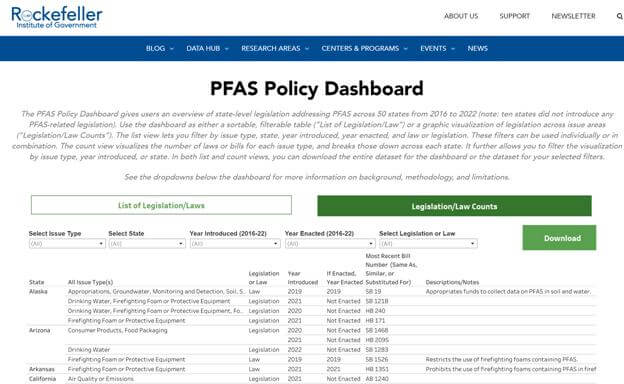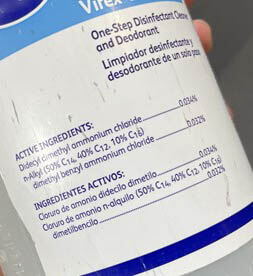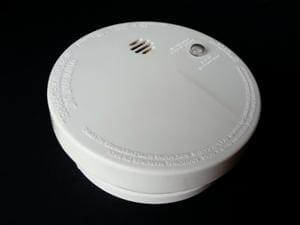August 2023: The Six Classes are in Session
In this edition:
- Update on QACs in Gyms
- Intruder Alert: PFAS Found Aboard the International Space Station
- Are There Batteries in Your Smoke Detector?
- PFAS Regulation Roundup
- Useful Resources on Our Websites
- Green Science Policy Institute in the News
Summer is coming to a close and the back-to-school season is underway. Parents are ticking the boxes on shopping lists and teachers are setting up their classrooms. How can they ensure they choose products without harmful chemicals? Well, it’s tricky, but learning about the Six Classes can help.
If you go to our website SixClasses.org, you can watch informative four-minute videos on each of these classes of chemicals of concern. Together, they make up a large part of the harmful chemicals in everyday products: PFAS, antimicrobials, flame retardants, bisphenols and phthalates, some solvents, and certain metals. We suggest spending half an hour viewing the introduction and the following six videos to learn where these chemicals are used, why they are harmful and what you can do to reduce your exposure and prevent harm.
Members of the six classes can lurk in all kinds of school supplies. For example, our study last year found PFAS in all “stain-resistant” school uniforms tested. A new analysis found that 68 percent of kids’ backpacks tested had PFAS. To avoid them, steer clear of products marketed as waterproof or stain-repellant, consult our PFAS-free list, and tell manufacturers that you want PFAS-free products.
Another concern is the unnecessary use of quaternary ammonium compounds (QACs) to wipe down desks, spray classrooms, and disinfect hands. These antimicrobials can cause skin irritation, adverse respiratory effects, and may be related to antibiotic resistance. Their use became widespread in response to the COVID-19 pandemic when we had limited information about the virus. However, there is no evidence that QACs help reduce the spread of COVID-19 in schools. Good ventilation, cleaning hands and surfaces with regular soap and water is best. You can learn more from our recent paper Quaternary Ammonium Compounds: A Chemical Class of Emerging Concern.
Schools aren’t the only facilities with a QAC problem. So far, a little over half of the gyms, yoga studios, and physical therapy facilities we’ve surveyed are using them. Wiping equipment with QACs quickly in between users isn’t just potentially harmful, but also ineffective— these compounds usually need to be left on surfaces for as long as ten minutes to work! Thank you to those who already sent in information from your own gyms. We are extending the deadline for contributions to our study until August 28. See blurb below for more about how you can help by sending us this short survey.
Finally, we appreciated the long feature on PFAS that was printed in the New York Times Sunday magazine this month. Writer Kim Tingley weaves together what we know about PFAS health effects with stories from PFAS researchers and people in the Faroe Islands. It’s astonishing that forever chemicals reach—and harm—even these remote residents. (See blurb below about how they have even reached the International Space Station.)
We’re also pleased that the article expresses skepticism about the American Chemistry Council’s position that PFAS shouldn’t be managed as one class. “To consider them individually would be virtually impossible — which might well be the point,” Tingley writes. Our Institute has been working to stop the use of PFAS for over a decade and do appreciate the wide attention they are now receiving.
Best wishes,
Arlene and the Green Science Policy team
P.S. I am hiring a part-time personal administrative assistant for four to six hours per week of flexible work in Berkeley. Applicants should email me why they are interested and their resume.
Update on QACs in Gyms
by Maya Carpenter
Are you surprised to learn that the cleaners used ingyms, yoga and physical therapy facilities might well contain harmful chemicals in an attempt to prevent disease? If you go to a gym or similar place, please help us learn more by filling out this this short survey.
As discussed in last month’s newsletter, we are surveying the active ingredients in gym equipment cleaners following our recent paper on quaternary ammonium compounds (QACs) used as antimicrobials. Over half of the gym cleaners in our study contain QACs, a class of chemicals that can cause skin irritation, adverse respiratory effects, and may be related to antibiotic resistance. And unless left on surfaces for as long as ten minutes, many QACs are not effective!
Several facilities we surveyed used diluted hydrogen peroxide which is more effective than QACs with less potential for harm. Other safer alternatives include citric acid and lactic acid. Ventilation to increase airflow and cleaning surfaces with soap and water are ways to reduce the spread of microorganisms without the use of harmful chemicals.
Thank you to those who already sent us information from your gyms. We are extending the deadline for contributions to our study until August 28.
If you go to a gym, yoga studio, physical therapy facility, or similar place that uses cleaning solutions on exercise equipment, please help us by filling out this short survey and sending us a picture of the ingredients list on the cleaner bottle if possible. Or email us at [email protected] with the name, ingredients and a photo of the cleaner ingredients list as well as the name & location of your gym. Please use the subject line "Gym project". Many thanks!
Intruder Alert: PFAS Found Aboard the International Space Station
by Lydia Jahl
A favorite way to try to avoid pollution is to escape to nature far from populated areas. But a new study suggests that pollution cannot easily be avoided—even in space! Scientists from the University of Birmingham and NASA analyzed dust from the International Space Station (ISS) and found an abundance of chemical pollutants including flame retardants, PFAS, and more.
While these findings aren’t surprising since previous research analyzing space station dust suggested the presence of fluoropolymers, they are still concerning. Because the station was built several decades ago, some of the chemicals commonly detected, like polybrominated diphenyl ethers (PBDEs) and PFOA, have since been phased out of use due to their health and environmental harms. Furthermore, most chemicals were found in higher concentrations than average terrestrial household dust, likely due to stringent flammability requirements, waterproof coatings, and the large amount of electronics and other equipment fitted into a small area on the ISS.
Back here on Earth, similar flammability standards are often found to expose us to harmful chemicals without a fire-safety benefit. Spacecraft may have more necessary uses of these chemicals, but greater protection is needed for the few astronauts that call the ISS home. On Earth, it's easy to reduce our exposure by opening windows and wiping down dusty surfaces, but it's not that simple in zero gravity environments! The study's authors pointed out that the ISS filters its air, but it is unknown how much this removes the wide variety of harmful chemicals.
The International Space Station will be removed from orbit at the end of 2030 due to its advanced age and degrading materials. In its place, commercial space stations will be built in Earth's lower orbit and NASA will build a new space station closer to the moon. We hope that engineers and designers use safer chemicals in the products onboard.
Are There Batteries in Your Smoke Detector?
Have you ever removed the batteries from your smoke detector because it annoyingly went off while you were cooking or showering, or for no apparent reason at all?
Good, functioning alarm systems will protect us from fires in our homes; they are a more effective and healthier option than adding flame retardants to furniture. Photoelectric smoke alarms are a better alternative than the more commonly-used ionization smoke alarms—they can detect smoldering fires smoke and do not give so many false alarms.
Photoelectric alarms are now required in Massachusetts, and data shows that they have led to a decrease in fire deaths. You should periodically check your smoke alarms to verify that they are functioning. If you have disabled your smoke alarms because of frequent false alarms, you might want to consider installing a photoelectric alarm.
PFAS Regulation Roundup
by Ariana Spentzos
Curious about your state's approach to tackling PFAS? Fortunately, the Rockefeller Institute of Government, a nonpartisan think tank, has developed a new dashboard to monitor PFAS-related legislation from 2016 to 2022 across different states. This user-friendly tool allows you to filter and search by specific issues (such as consumer products, wastewater, soil, etc.), year of legislation introduction, enactment status, and state.

The data is sourced from Legiscan.com, a legislative data tracking service, and the dashboard plans to receive annual updates and extend its coverage to federal legislation in the future. All datasets are downloadable for in-depth analysis, complemented by informative heatmap visuals highlighting the most addressed issues.
There is also a similar dashboard regularly updated by the nonprofit organization Safer States. Both tools can both be found on our PFAS data hub, which we have recently updated with more comprehensive state-level data on PFAS levels in drinking and surface water. We now have links for interactive maps and monitoring data for most states, and we'll continually update these resources as more states conduct PFAS testing and disclose their findings.
For authoritative PFAS lists, biomonitoring resources, government tools, and more, explore our PFAS data hub!
Useful Resources on Our Websites

GreenSciencePolicy.org has consumer tips for reducing exposure to harmful chemicals, guidance for scientists on communicating their research, our latest press releases and newsletters, our scientific publications, and more.
PFASCentral.org curates the latest news, research, policy, and events related to PFAS. It also has our popular and growing PFAS-free list of products. We also host a data hub of searchable databases of PFAS information.
SixClasses.org has four-minute videos on the six classes of chemicals of concern: PFAS, flame retardants, antimicrobials, bisphenols and phthalates. some solvents, and certain metals. It also has instructions for manufacturers, retailers, designers, and large purchasers to avoid using whole classes of chemicals of concern in consumer products and building material.
Green Science Policy Institute in the News

By Rebecca Fuoco
Below are recent news articles, blogs, podcasts, newsletters, and more that have featured our Institute’s work and expertise.
- The Journalist’s Resource from the Harvard Kennedy School discussed our analysis of PFAS research communications in an explainer and tip sheet for reporters.
- The Minnesota Reformer interviewed our scientist Ariana Spentzos for an article warning about local PFAS river contamination and fish. “Personally, I wouldn’t eat those fish,” she said.
- Mamavation cited our PFAS-free list as a source for their recent guide on PFAS in backpacks.
- Arlene was quoted in an article on The Filtery about PFAS in outdoor gear. PFAS “…never break down, and all of the ones that have been studied have been found to be harmful,” she said. The article links to our PFAS-free list.
- An article from MDLinx includes our advice about avoiding PFAS in clothing.
Receive Updates By Email
Subscribe to our monthly newsletter and get these updates delivered right to your inbox!





